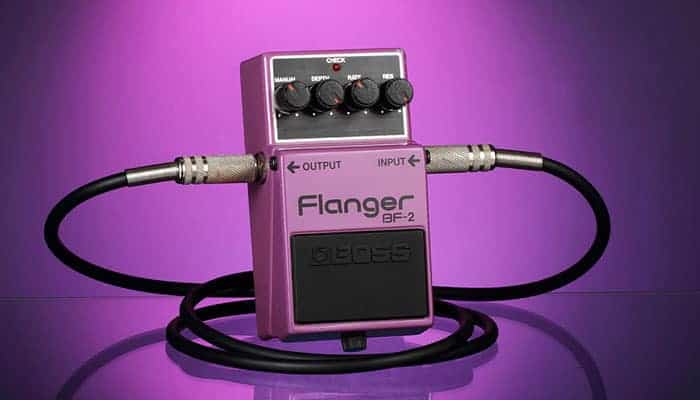Among many wonderful and weird effects that you will find available on the market, only a few effects possess humble roots as the flanger effect does. What we find unique about the flanger effect is its way of changing tones in unimaginable ways.
There are so many options and ways a flanger effect can change your tone, and that’s why we have brought you this review which addresses the question, “what does a flanger pedal do”?
The flanger pedal was discovered by Les Paul back in 1940. Since it was first discovered, experimentalists, audio manufacturers, and mix engineers have found a way to replicate the flanger effect countless times.
Copying signal and delaying its playback by varying amounts explains how a flanger pedal obtains its unique sound ability. The variation is brought about by a low-frequency oscillation, amount, depth, and speed of an altered signal to be adjusted to a user’s taste.
Despite the numerous flanger effect you will encounter on the market, they all maintain the same principle. Its principle is delivering an instant jet engine quality, played across so many genres.
You need to have a flanger effect or be familiar with a flanger pedal to explore its unique abilities. You also need to figure out a way to incorporate a flanger effect into your sound. At the end of this review, you will be a step closer to finding the right flanger pedal for you.
Content Navigation
What Does A Flanger Pedal Do?

People always ask, what does a flanger pedal do? This is an excellent question, and we are going to answer it immediately. Mixing two identical signals, but one of the signals gets delayed by varying and small periods determined by a low-frequency oscillation explains what a flanger does.
It will create a swirling harmonic effect, and the two signals possess varying spaces which weave in and out of each other, causing the harmonic to move around the frequency spectrum. This swirling harmonic movement creates the jet engine sound we mentioned earlier, and the jet engine sound is an easy way to identify flangers.
Feeding back the output partially into the input creates feedback that provides sound with another dimension. However, paying close attention to the explanation we have given about flangers, you will agree with me that other modulations work in similar ways.
These modulations mix dry signals with a detuned and filtered signal to create an abstract sound. Mixing up these modulations is very easy as each modulation uses a low-frequency oscillation in creating modulated effects only when slightly tweaked. So, how can you differentiate a flanger from a chorus and phaser?
A flanger makes use of a low-frequency oscillation in adjusting a signal’s delay, while a phaser uses a low-frequency oscillation to adjust your waveform’s phase. Lastly, a chorus utilizes a low-frequency oscillation in adjusting pitch.
When it comes to using a flanger pedal, you need to consider a couple of things because it is far from being regarded as the most subtle effect.
Altering tones in a transparent and significant way instead of a fun way is what a flanger is capable of doing, so you need to have additional knowledge of its controls if you intend to make the most of a flanger’s boldness. A flanger has three key controls, so let’s show you what each control does precisely.
Depth
The depth is referred to as wet/dry or mix, and it serves as a control between the dry input signal and the amount of effect applied. If you set your depth to a minimum, a faint suggestion of modulation is what you will obtain, but setting a full depth creates shimmering and sway tones.
Rate
The rate can also be referred to as speed, and you can already tell that the rate controls a signal delay’s speed variation. For example, chunky jet engine sounds that flangers are known for will be created when you set a slow rate, but you will hear communications from outer space if you set your rate fast.
Feedback
The feedback controls the amount of output signal fed directly into the input signal. As a result, you can sometimes use the feedback in creating dramatic effects that provide your sound with distorted, otherworldly tone quality.
Where To Place A Flanger On Your Signal Chain
Just like every other modulation effect, a flanger pedal will comfortably sit at the back end of a pedal chain, and it will be best or will deliver the best results if you place a flanger after every other thing, but make exceptions when it comes to effects like delay and reverb.
We are trying to say that the flanger effect applies to everything on a pedal chain, including filters, equalizer, distortion, and more. It is fun to play around with the flanger because you are guaranteed to create abstract sounds.
The flanger pedal is for adventurous people at heart, and if you want to get that bonker tone, place your flanger before a fuzz pedal or distortion. The control on any flanger unit is simple, but they can create several distinct sounds when manipulated.
The fact is you might have listened to your favorite albums and heard modulated, weird guitar sounds that left you puzzled about what they are. At the end of this review, identifying or telling the difference shouldn’t be a problem for you anymore because having a flanger in your setup is more of a reality check.
Musicians are always out to boost their craft, and there are lots of flanging tools and techniques they can use to create adventurous sounds. The flanger guitar effect is one of the tools they can rely on to enhance their craft, and regardless of whatever genre of music you play, a flanger guitar effect will modify the sound in subtle ways.
However, choosing the right flanger pedal will help you get the best out of any instrument. With the information gathered in this review, you will identify what features and controls you want from a flanger effect pedal.
Related Posts
What Does An Overdrive Pedal Do

